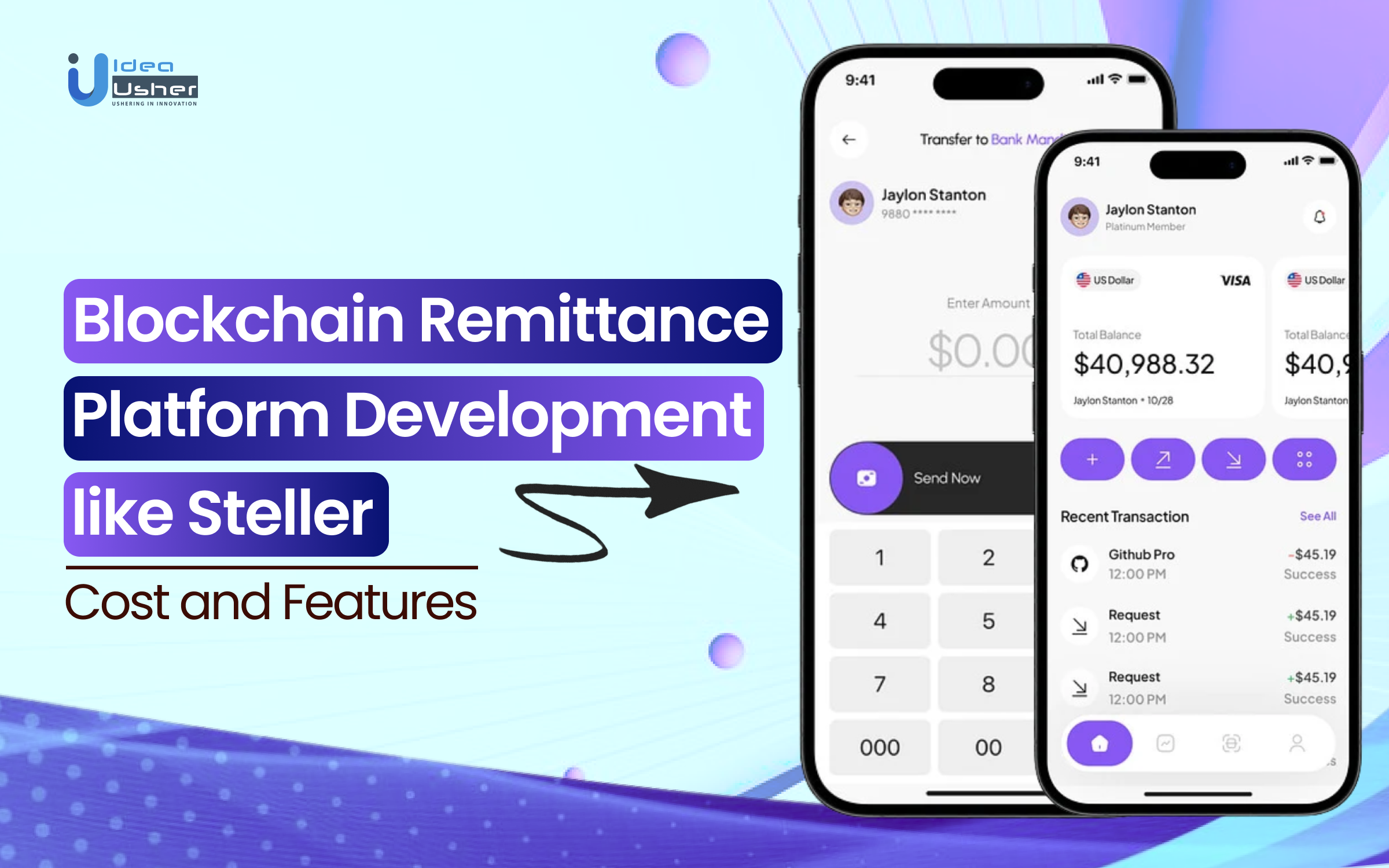Remittances are a lifeline for millions of families around the world, but traditional money transfer services often come with high fees and slow processing times. Blockchain technology is changing the game by offering a faster, more affordable way to send money across borders. Platforms like Stellar are leading the way in making international transfers secure, cost-efficient, and accessible to everyone. According to a 2023 World Bank report, the global average cost of sending remittances was 6.3%, but blockchain solutions are rapidly reducing this burden.
One popular platform making waves in this space is Remitly, founded in 2011 and based in Seattle. Remitly focuses on helping immigrants send money back home quickly and affordably. In 2023, they generated an impressive $400 million in revenue, showing just how much demand there is for easier, cheaper remittances.
If you’re considering building a blockchain-based remittance platform, you’re entering a fast-growing and impactful industry. In this blog, we’ll break down the key steps involved in creating a platform like Stellar—starting with understanding the technology, building the core features, and integrating solutions that make sending money across borders simple, secure, and affordable for everyone.
Overview of the Stellar Platform
The Stellar blockchain remittance platform is a decentralized network designed to make cross-border money transfers faster, cheaper, and more efficient. Using blockchain technology, it connects financial institutions and service providers, allowing users to send and receive money in a wide variety of currencies, including both traditional money (like USD and EUR) and cryptocurrencies.
Key Features
Here are some key benefits of using the Stellar platform:
- Fast Transactions: Transfers are completed in under 5 seconds, much quicker than traditional remittance services, meaning users can access their money almost instantly.
- Low Fees: Stellar’s fees are incredibly low, often just a fraction of a cent for every 100,000 transactions, making it an affordable choice for users.
- Multi-Currency Support: Users can send and receive money in a variety of currencies, seamlessly handling everything from fiat to crypto.
- Integration with Anchors: Stellar connects users to anchors—financial institutions that help send and receive money in the traditional banking system, bridging the gap between the old and new financial worlds.
Key Market Takeaways for Blockchain Remittance Platforms
According to StraitsResearch, the global digital remittance market is booming. Valued at $22.72 billion in 2023, it’s projected to grow to $26.26 billion in 2024 and reach $83.74 billion by 2032, driven by a strong growth rate of 15.6% annually. This growth is largely due to the rising number of migrants from developing countries to developed ones, coupled with increasing internet access.
Source: StraitsResearch
Blockchain-based remittance platforms are gaining popularity, and for good reason! These platforms are proving to be highly effective in streamlining cross-border transactions. Ripple is one of the leaders in this space, offering a powerful system that allows banks and financial institutions to process real-time global payments. RippleNet, its network, is now used by over 175 banks, cutting down transaction times from days to just minutes.
Another major player is Stellar, which has teamed up with MoneyGram to facilitate smooth international money transfers. Stellar’s blockchain technology makes remittances quick, inexpensive, and simple, making it an attractive choice for users looking for efficient financial solutions.
Partnerships are key to the success of these platforms. For instance, Volabit and SatoshiTango have partnered to create Coinnect, a service that allows instant, low-cost transfers between Mexico and Argentina. These collaborations help expand the reach and effectiveness of blockchain remittance services, offering even more affordable and convenient options for users worldwide.
Work with Ex-MAANG developers to build next-gen apps schedule your consultation now
A Perfect Time to Invest in Blockchain Remittance Platform Development
Now is a great time to invest in blockchain remittance platforms like Stellar. The global remittance market is worth over $700 billion, with millions of people sending money internationally. Traditional services can be slow, expensive, and lack transparency, creating demand for better options. Blockchain, like Stellar, offers fast, low-cost, and secure transfers, making it a strong competitor to traditional platforms. It also reduces fees and scales easily, ensuring it can handle growing transaction volumes.
Platforms like Wise and WorldRemit have already proven their potential in the remittance space. Wise, for instance, earned around $500 million in 2023 thanks to its low fees and transparent service. WorldRemit, with its broad customer base and international reach, generated roughly $300 million in the same year.
This success shows that there’s clearly room in the market for innovative solutions, and blockchain remittance platforms are well-positioned to step in and offer more efficient alternatives.
The rise of DeFi and cryptocurrencies opens even more doors for blockchain remittance platforms, creating exciting opportunities for new revenue streams, such as transaction fees and strategic partnerships. Given the success of existing players, it’s clear that this industry is thriving, and blockchain could provide the competitive edge needed to capture a significant share of the market.
Business Model of the Stellar Blockchain Remittance Platform
The business model of the Stellar platform focuses on building a global payment network that connects financial institutions, businesses, and individuals through its anchor system. Anchors are trusted entities that act as bridges between fiat currencies and digital assets, ensuring smooth exchanges on the Stellar network. These anchors also handle important tasks like complying with regulatory requirements such as KYC and AML protocols.
Stellar supports a variety of use cases, including:
- Remittances: Helping individuals send money across borders quickly and affordably.
- Payroll Solutions: Enabling businesses to pay employees in different countries without hassle.
- Supplier Payments: Streamlining payments to suppliers around the world.
- E-commerce Transactions: Assisting online merchants in accepting payments from customers in various regions.
The Stellar network is designed for easy integration, allowing businesses to directly connect to its infrastructure while ensuring compliance with local regulations.
Partnerships and Collaborations
Stellar has formed key partnerships with companies like Circle and MoneyGram. These collaborations enhance its remittance capabilities by integrating USDC (a stablecoin) into the Stellar ecosystem and expanding the ability to send money across borders using MoneyGram’s global network. These partnerships are essential for growing Stellar’s reach and making it more accessible to mainstream financial users.
Financial Performance
Stellar’s financial performance has been strong, with its XLM token reaching a market capitalization of around $11.2 billion by late 2024. This reflects growing investor confidence and increasing usage of the platform. The trading volume of XLM has been consistently high, averaging about $199 million daily. Analysts predict further growth for Stellar, which is fueled by strong market trends and technical momentum.
Development Steps for a Stellar Blockchain Remittance Platform
Developing a Stellar blockchain remittance platform involves a structured process to ensure efficiency, scalability, and security. Below are nine unique developmental steps:
1. Define Business Objectives
Identify the platform’s core purpose, target users, and the key problems it aims to solve. This includes understanding regulatory requirements, market needs, and desired features like real-time currency conversion and low transaction costs.
2. Plan System Architecture
Design a robust and scalable architecture to connect multiple stakeholders, such as banks, payment systems, and individual users. Incorporate Stellar’s decentralized framework to enable seamless cross-border transactions and asset transfers.
3. Integrate Anchors
Set up trusted entities called “anchors” to act as gateways between traditional financial systems and the Stellar network. Anchors enable users to deposit and withdraw money in their local currencies and facilitate asset exchanges on the network.
4. Implement the Stellar Consensus Protocol
Incorporate Stellar’s SCP for transaction validation. This consensus mechanism eliminates the need for mining and ensures fast and secure transaction processing, typically under five seconds.
5. Develop Cross-Currency Transaction Features
Build functionalities for real-time currency conversions. Utilize Stellar’s built-in decentralized exchange to facilitate smooth cross-currency transactions at competitive rates.
6. Ensure Security and Compliance
Implement robust security measures to protect user data and transactions. Integrate compliance mechanisms for anti-money laundering (AML) and know-your-customer (KYC) regulations to align with legal requirements in different jurisdictions.
7. Create a User-Friendly Interface
Design an intuitive platform interface for end-users, including mobile and web versions. Ensure the interface supports seamless navigation for depositing, transferring, and withdrawing funds.
8. Conduct Rigorous Testing
Perform comprehensive testing to identify and resolve bugs or performance issues. Validate the platform’s scalability and reliability by simulating various transaction volumes and network conditions.
9. Deploy and Monitor
Launch the platform and monitor its performance post-deployment. Gather user feedback and analyze metrics to identify improvement areas. Roll out regular updates to enhance functionality and user experience.
Cost of Developing a Blockchain Remittance Platform like Stellar
| Stage | Description | Cost Range |
| Research & Feasibility Study | Conduct market research, evaluate blockchain options, and define the business model. | $1,000 – $5,000 |
| – Market Research: Identifying target audience, competitive analysis, and regulatory landscape. | ||
| – Technical Feasibility: Evaluating Stellar integration, API requirements, and security considerations. | ||
| – Business Model: Revenue streams, pricing, and go-to-market strategy. | ||
| Frontend Development | Design and develop the user interface (UI) and user experience (UX) for the platform. | $2,000 – $15,000 |
| – UI/UX Design: Intuitive, user-friendly interfaces for web and mobile platforms. | ||
| – Web & Mobile App Development: Responsive design for cross-platform compatibility. | ||
| Backend Development | Implement the Stellar network integration and backend logic. | $3,000 – $25,000 |
| – Stellar Integration: Enable secure communication with the blockchain network. | ||
| – Smart Contract Development: Implement escrow services, KYC/AML checks, and automated workflows. | ||
| – Database & API Development: Develop secure databases and APIs for transaction storage and gateway integration. | ||
| App Features | Build and integrate essential and optional features. | $2,000 – $15,000 |
| Core Features: | ||
| – User registration and authentication | ||
| – Wallet creation and management | ||
| – Fund transfer (domestic & international) | ||
| – Transaction history and tracking | ||
| – Currency conversion and exchange rates | ||
| Advanced Features (Optional): | ||
| – Bill payments, peer-to-merchant payments, loyalty programs, multi-signature transactions, biometric authentication. | ||
| Testing & Quality Assurance | Ensure platform reliability, security, and user satisfaction. | $2,000 – $10,000 |
| – Unit Testing: Validate individual functionalities. | ||
| – Integration Testing: Test module interoperability. | ||
| – User Acceptance Testing (UAT): Gather real-world user feedback. | ||
| – Security Audits: Conduct penetration testing and vulnerability assessments. |
Total Estimated Cost: $10,000 – $100,000
Variable Factors Affecting the Development Cost of a Blockchain Remittance Platform
Several factors can significantly impact the development cost of a blockchain remittance platform, particularly those unique to the complexities of blockchain technology and the specific needs of a remittance service.
- Blockchain Platform Selection: Choosing a platform like Stellar comes with its own set of development costs. Factors like transaction fees, network congestion, and the complexity of integrating with the Stellar ecosystem can influence the overall budget.
- Smart Contract Complexity: The sophistication of smart contracts for features like escrow, multi-signature transactions, and automated compliance checks directly impacts development time and cost.
- Regulatory Compliance: Navigating the constantly evolving regulatory landscape for cryptocurrency and remittances in various jurisdictions requires legal expertise and can significantly impact development timelines and budget.
- Security Audits and Penetration Testing: Ensuring the security of a blockchain-based platform is paramount. Regular security audits and penetration testing are crucial, adding to the overall development and ongoing maintenance costs.
Conclusion
Blockchain remittance platforms like Stellar can make a big difference for everyday people by making international money transfers faster, cheaper, and more transparent. With lower fees, quicker transactions, and better security, these platforms bring real benefits. Businesses can take advantage of this by creating similar platforms and earning money through transaction fees, premium services, and partnerships with banks. By using blockchain technology, businesses can offer fresh solutions to the problems of traditional money transfer systems, attract lots of users, and shake up the market.
Looking to Develop a Blockchain Remittance Platform like Stellar?
With over 500,000 hours of experience in blockchain development, Idea Usher is here to help you create a secure and scalable remittance platform like Stellar. We specialize in building innovative blockchain solutions that make cross-border money transfers faster, cheaper, and more transparent. Our expert team will be with you every step of the way—from the initial idea to the final launch—ensuring your platform is secure, scalable, and user-friendly.
Work with Ex-MAANG developers to build next-gen apps schedule your consultation now
FAQs
Q1: How to develop a blockchain remittance platform?
A1: To develop a blockchain remittance platform, you’ll need to integrate blockchain technology to ensure secure, transparent, and fast money transfers across borders. This involves selecting the right blockchain network (e.g., Ethereum, Stellar), developing a user-friendly interface, integrating APIs for currency conversion and payment processing, and implementing robust security features like encryption and multi-signature wallets to protect users’ funds.
Q2: How does a blockchain remittance platform make money?
A2: A blockchain remittance platform typically makes money by charging small transaction fees, which can be lower than traditional remittance services. These fees may be per transfer, based on transaction size, or a flat rate. Some platforms also offer premium features, like faster transfers or additional services, to generate extra revenue.
Q3: What are the features of a blockchain remittance platform?
A3: Key features of a blockchain remittance platform include fast cross-border payments, low transaction fees, security through encryption and decentralized protocols, multi-currency support, real-time tracking, and transparency. Additionally, it may offer a user-friendly mobile app, automated compliance with regulations, and a seamless onboarding process for users.
Q4: How long does it take to develop a blockchain remittance platform?
A4: The development time for a blockchain remittance platform can vary, but typically it takes anywhere from 6 months to 1 year. This depends on factors like the complexity of the platform, the blockchain network chosen, the number of features, and the development team’s expertise. Testing and compliance integration can add extra time to the process.






















